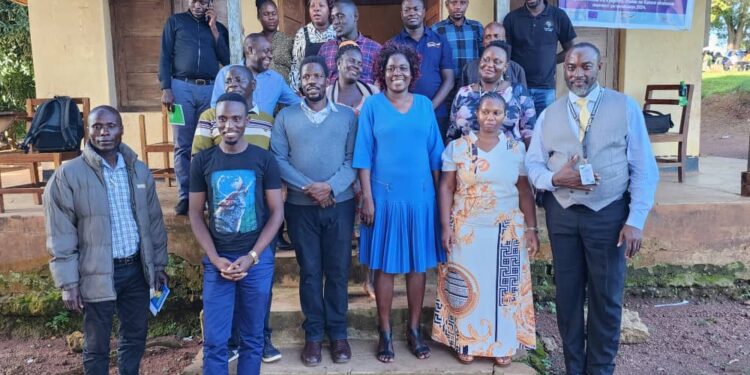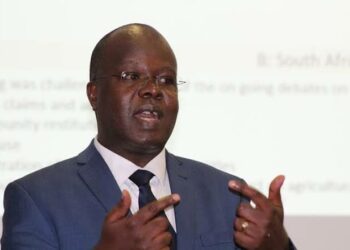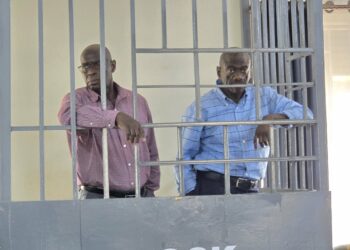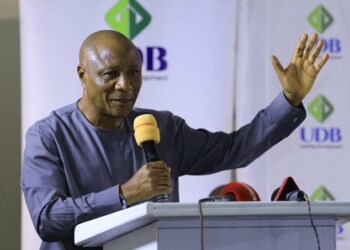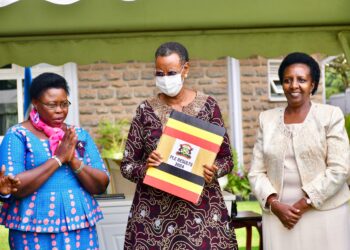The Uganda Investment Authority (UIA), Eastern and Southern Africa Small Scale Farmers Forum (ESAFF Uganda), and Giz have advocated for a unified approach to economic growth through facilitating strategic investments.
These organizations are working towards achieving the objective of economic growth in Uganda, through strategic investments by creating a conducive environment for the establishment of Local Economic Development and Investment Committees (LEDICs)
Peter Muramira, the Deputy Director of Business Development at UIA took the lead in popularizing this approach. He emphasized the crucial intersection of local economic development and district investment.
Addressing leaders of Gomba District Local Government at Nakyegonza Subcounty headquarters in Gomba, on the vitality of LEDICs to economic growth, he stressed that this synergy would be pivotal in driving progress towards strategic investments.
“We all want to achieve one thing: local economic development and job creation. We want to industrialize our country,” Muramira affirmed.
To realise the sucessful establishment of these committes, he outlined a series of planned engagements, including convening chief administrative officers from across the country to deliberate on this collaborative effort.
He expressed the need to bring together chairpersons from various committees and educate them on the initiative’s purpose and potential impact. He emphasized, “We want to sensitize everybody. We want to make sure that everybody is moving together in the same direction.”
He underscored the shift away from isolated efforts, declaring, “We are no longer working in silos because it has failed to work.”
Muramira highlighted the collaborative strides made between the local government ministry and UIA, stating, “We are now saying yes, you’re doing something in the direction of Local Economic Development. I’m doing something along the lines of district investment committees.”
Citing the decentralization policy as a foundation, Muramira detailed the strategy focused on promoting investments and fostering development in local governments as a cornerstone of the LEDIC initiative.
“When you are doing something, let it be a chapter that we are going to now identify coffee growers together, we are going to identify maize growers together,” he urged. He explained that UIA’s role would be to provide the necessary facilitation, addressing specific needs such as financial inclusion, business plans, and formalization of operations.
Muramira stressed the significance of business registration, for several business investments to reap incredibly big the LEDIC initiative, emphasizing, “Know who they are, by name, then you can come and support them. That is our job, business facilitation”
Significance of LEDIC in Strategic Investment Decision-Making
At the moment, two committees oversee the advancement of Local Economic Development and Investment within local governments. These are the District Implementation Committees (DICs), presided over by District Chairpersons, and the District Local Resource Teams (DLRTs), led by Chief Administrative Officers.
It has been observed that these committees share a similar composition and perform overlapping functions, which can lead to potential conflicts and role ambiguities.
In order to establish a more robust and efficient framework for local governance in the context of Economic Development and Investment Promotion, a new entity known as the Local Economic Development and Investment Committee (LEDIC) has been established.
LEDIC is slated to become operational across Districts, Cities, Municipalities, Town Councils, and other Lower Local Government units.
While addressing Gomba District Local Government Leaders, Ronald Bagaga, the Program Officer for Research and Policy at ESAFF Uganda said the purpose of LEDIC is to build up the economic capacity of a local area, to improve its economic future and the quality of life for all.
“LEDIC is important because it is intended to create a conducive environment for investment, increase household incomes, and generate higher revenues for Local Governments, ultimately translating into improved service delivery and wellbeing of the people,” he said.
Furthermore, there has been a noticeable shrink in Central Government Transfers to Local Governments. This necessitates the need to complement Government efforts for development through mechanisms like LEDICs. These committees play a pivotal role in resource mobilization for non-traditional investments, a view shared by Bagaga.
In addition, LEDICs address the pressing issue of escalating unemployment rates, both in off-farm and on-farm sectors. They work towards increasing and improving household incomes and raising general standards of living for communities.
Moreover, LEDICs contribute to diversifying the local revenue base for Local Governments, allowing them to have a more stable financial footing. This, in turn, enables them to contribute to service delivery through co-financing arrangements and covering operation and maintenance costs.
LEDICs also allow for the efficient allocation of resources and supports various functions such as councilors’ allowances and representation, reinforcing the democratic process at the local level.
Cutting-Edge Q-GIS Empowers Gomba District’s Investment Landscape
In a groundbreaking move, the Quantum Geographical Information System (Q-GIS) has been entrusted to Gomba district local government by ESAFF Uganda, revolutionizing the way specific investment areas are mapped.
This cutting-edge system boasts the capability to analyze every physical feature within the district, including ecologically sensitive zones, presenting clear directives on viable and restricted investment zones.
Hanington Kimela, an adept ICT technician, elucidated the system’s intricate workings during his address. He emphasized, “The system’s primary function is to chart out various investment opportunities using GPS technology. To accomplish this, we rely on the cooperation of Parish chiefs and other department heads to gather this crucial information. With access to this data, we can efficiently inform interested parties. Think of us as the investor’s keen eye, poised to provide essential insights. This information equips us to make informed decisions.”
With precision and foresight, Q-GIS stands ready to guide potential investors towards optimal opportunities. Kimera continued, “For instance, if the Uganda Investment Authority approaches us with a potential investor keen on agriculture or coffee ventures, we will have the precise locations ready. This enables us to offer tailored guidance.”
Innovative Tool Enhances Investor Compliance Monitoring in Gomba District
In a groundbreaking initiative, the Investor Compliance Monitoring Tool (ICM Tool), also a brainchild of ESAFF Uganda and Giz was employed to assess investor adherence to environmental, societal, and state objectives in Gomba District. Ten officials from various departments within Gomba DLG were meticulously trained to proficiently utilize this tool.
Venturing into the field, these officials meticulously gathered data from 25 targeted investments in the district, with guidance and logistical support provided by ESAFF staff members. The ICM Tool encompasses seven pivotal sections, ranging from contributions to food security and nutrition to fostering gender equality and inclusive governance structures.
This cutting-edge tool has yielded numerous benefits, including the identification and mapping of investments in Gomba District, along with documenting their contributions to growth and development. Furthermore, it ensured compliance with local laws and policies while spotlighting areas of knowledge gaps, challenges faced by investors, and their revenue contributions.
Notably, the ICM Tool also played a crucial role in advocating for human rights and workers’ rights, and it facilitated the establishment of effective grievance handling mechanisms in workplaces. This comprehensive approach has proven to be a significant stride toward sustainable and responsible investment practices in the district.
District Government Local Leaders’ Perspectives
Morgan Kawalya, the District Community Development Officer (DCDO) for Gomba, emphasized that upon the establishment of the committee, it is anticipated that a diverse range of investors will be attracted to Gomba and neighboring districts. This influx of investment is expected to lead to similar progress and, consequently, generate much-needed opportunities for growth, benefiting both the state and its residents.
He stated, “The Committee will hold the authority and influence to not only draw in, but possibly regulate both local and foreign investors within the district.”
Kizito Martin Luther, the District Planner, pointed out that while Gomba has an improvement plan in place, regrettably, their strategy for local economic development was lacking. He emphasized that this gap would be addressed with the establishment of the committee.
Mariam Meeme, a member of the Gomba District Council, echoed Kawalya’s sentiments. She stressed that the committee would play a pivotal role in connecting local and foreign investors with the abundant investment opportunities available in the district.
The Responsible Governance for Investment in Land (RGIL) initiative is currently underway in six districts of central Uganda, including Kassanda, Mubende, Mityana, and Gomba. This initiative receives direct support from the European Union and German Cooperation.
RGIL constitutes a critical component of the broader Responsible Land Policy in Uganda (RELAPU) Project. Its execution is being conducted under the guidance of the Ministry of Lands, Housing, and Urban Development, in collaboration with the Uganda Investment Authority (UIA).
The overarching goal of the project is to ensure that agricultural investments in land are not only productive but also contribute to sustainable land management while respecting the rights and needs of the local population, particularly vulnerable groups and women.
Do you have a story in your community or an opinion to share with us: Email us at editorial@watchdoguganda.com


